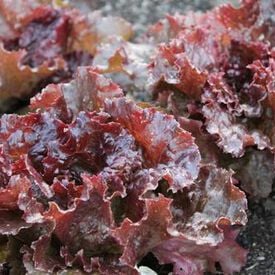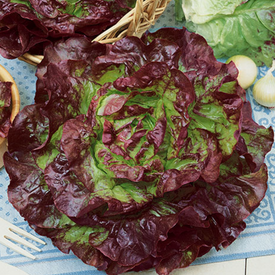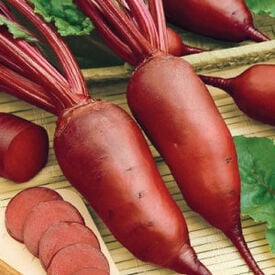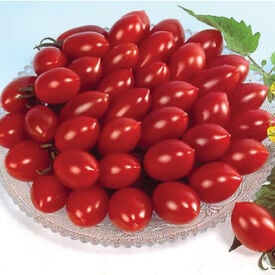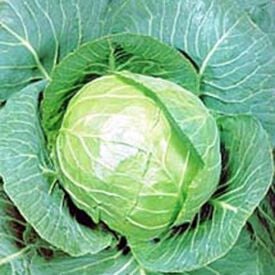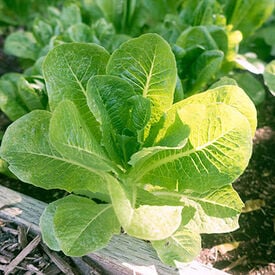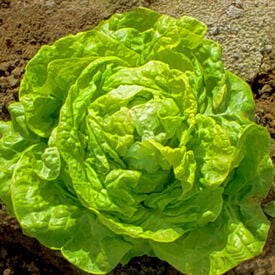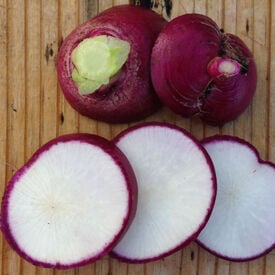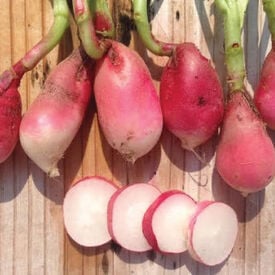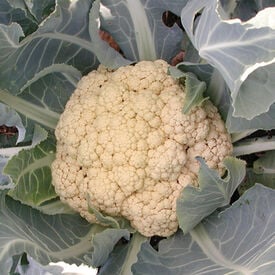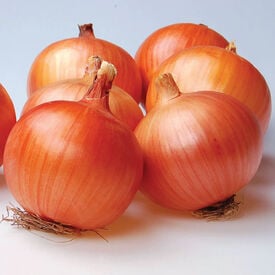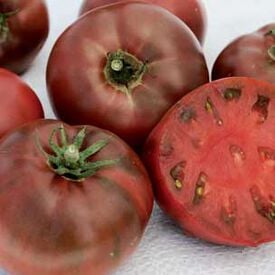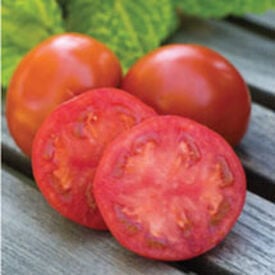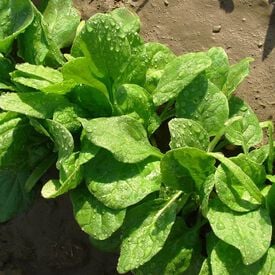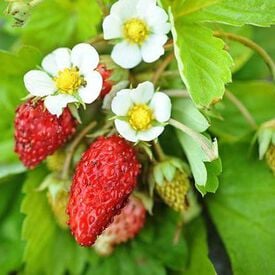The Red Sails Lettuce is a full rosette type that produces radiant bronze-red, ruffled and deeply lobed leaves that have a mild bitter-free flavor that pairs very well in salads. This slow-bolting lettuce is ready to cut early and holds its quality very well. Red Sails has six times the vitamin A and three times the vitamin C as other supermarket lettuces. This variety thrives in cool weather, but can also grow well in the spring, summer or fall.
Carmona Red is a favorite among many market growers! This lettuce variety produces big, bright red heads with lime green hearts. The Carmona Red has a nice silky texture and is very disease resistance.
Cylindra beets, also known as "Formanova" or "Butter Slicer," are a unique variety of beetroot known for their elongated, cylindrical shape. These beets have a fascinating history, originally hailing from Europe, particularly Denmark, where they were developed in the early 20th century. Their distinctive shape was cultivated to make them easier to slice and can, a practical innovation that has made them popular among home gardeners and commercial growers alike. In terms of taste, cylindra beets are mild and sweet, with a slightly earthy flavor. They are known for their tender, non-fibrous texture, making them excellent candidates for pickling, roasting, or slicing thinly for salads. Their deep red-purple skin contrasts beautifully with the vibrant, dark red flesh inside, adding an attractive element to culinary dishes. Cylindra beets typically grow to be 6-8 inches in length and 2 inches in diameter. They are ready for harvest in approximately 55-65 days from planting, making them a relatively quick-growing beet variety. They thrive in well-drained, loamy soil with full sun exposure. When it comes to disease resistance, cylindra beets tend to be more resistant to common beet diseases like leaf spot and powdery mildew than some other beet varieties. Proper spacing is crucial, with about 2-3 inches between each plant and rows spaced 12-18 inches apart. With the right care and growing conditions, cylindra beets can yield a bountiful crop of these delicious and uniquely-shaped vegetables, making them a favorite among gardeners and chefs.
2005 American Selection Tomato! Juicy half ounce fruits, pointed oval shape, reddish pink, very sweet. Ultra high sugar content (9.5 BRIX) make 1/2 ounce fruits irresistible. Very productive vines keep setting huge clusters of fruits all season long. Terrific curb appeal.
The Golden Acre is a tasty cabbage that arrives early and is suited for close spacing. This early round head cabbage is easily grown and versatile in use. Heads are about 6 to 7 inches in diameter on compact plants about a foot high. Its firm, medium green head is excellent cooked or raw in stews and salads.
The Little Caesar Lettuce is a very attractive tall romaine type with crisp, bright green outer leaves and golden-blanched inner leaves. This lettuce has a sweet, crunchy flavor that is delicious on any sandwich or salad. This variety is easy to grow and is perfect for smaller gardens. Little Caesar is best picked right before eating.
White Boston lettuce seeds produce an old heirloom butterhead variety known since the early 1900s for its soft, tender texture and reliable garden performance. The plants form loose, pale-green heads with broad, silky leaves that have a mild, buttery flavor and a pleasantly delicate crunch. This variety prefers cool weather, making it ideal for spring and fall planting, and thrives in rich, well-drained soil with consistent moisture. To grow it successfully, sow seeds shallowly, keep the soil evenly moist, provide partial shade in warmer climates to prevent bolting, and harvest heads when they are full and firm for the best flavor and texture.
The Purple Plum is an amazing purple skinned radish with a crisp, mild and sweet white flesh! This unique radish is different from the "typical" radish coloring. This small round shaped radish is early to harvest, which makes it great for home and market growers. Purple Plum is a nice variety to blend with other colors in mixes!
The French Breakfast Radish has a delicate flavor and is an excellent variety for home gardens. This radish variety is an attractive uniquely shaped radish with elongated roots and red tops with white tips. The French Breakfast has an excellent flavor and texture, that is perfect for dips or as a garnish.
The Snow Crown cauliflower is a delicious, mild and sweet hybrid. This cauliflower's head will get to 7-8 inches across and 1-2 pounds. The Snow Crown is extra early and adaptable and can be harvested in summer or fall. Be careful not to under-fertilize or water, stress can cause a purplish discoloration on the undersides of the head.
Caliber is a late-season yellow long day for the western United States known for vigor, disease resistance, yield, and storage capabilities. Caliber is a Celebrate hybrid with a healthy plant with solid roots and strong and erect tops that assist in providing thrips tolerance and make applications easier. Caliber has a consistent rich bronze scale in super colossal bulbs with single centers that do very well with a mechanical harvest. Caliber has a reputation for storing very well long term. Disease Ratings: HT to Pink Root and Fusarium, T to Bolting and HT for Thrips
The Carbon Tomato won the “Best Tasting Tomato Award” at the Heirloom Garden Show in 2005 and continues to rate very high in many taste tests! This tomato is one of the darkest of the “black tomato” varieties, and 10-12 oz. in size with a flattened round shape. This purplish-brown, "black" colored tomato has a deep brick red flesh and has a deliciously rich, sweet flavor. The fruit is medium to large, with a slightly flattened shape and a smooth, glossy skin. Carbon tomatoes are celebrated for their robust flavor profile, which blends sweet, tangy, and smoky notes, making them a versatile choice for fresh salads, sauces, and salsas. The plants are indeterminate, meaning they continue to grow and produce fruit throughout the growing season, typically reaching heights of 5 to 7 feet. They exhibit a vigorous growth habit and produce a steady yield of tomatoes from mid-summer to fall. Harvesting is usually done when the tomatoes have fully ripened and developed their deep color. With their rich flavor, striking color, and reliable productivity, Carbon tomatoes are a favorite among gardeners and culinary aficionados alike.
The Sweet Seedless Tomato is just like it name says, sweet with very few seeds! This juicy orange-red tomato variety is an extra tasty, very early tomato! Since this tomato has minimal seeds to digest, it offers a very outstanding taste. Since the Sweet Seedless does not store its sugars within its seeds, the sweetness is transferred to the flesh, making it extra tasty! This fast maturing, very sweet variety must be grown away from other tomatoes. Tomatoes may have some immature seeds.
The Beaver Dam Pepper is a delicious pepper that makes a great for stuffed peppers or adding to sandwiches. This pepper variety was brought from Hungary to Beaver Dam, Wisconsin in 1912 by the Joe Hussli family. Beaver Dam ripens from green to orange to red with just a touch of a tangy heat flavor!
The Viroflay Spinach is a gourmet French heirloom that was developed prior to 1866. The big, smooth leaves of this Spinach variety is a deep green color and grows up to 10 inches long. This very fast growing plant is popular for fall planting.
Alexandria is a delicious alpine strawberry that produces delicious fruit. Deep scarlet and fragrant aromatics, these strawberries are the size of wild berries. Alexandria is an everbearing strawberry that can produce the first year if planted early. These day-neutral plants stay compact and produce few runners. Excellent for pots and window boxes.
Federle tomatoes, also known as Federle's Italian Paste, are a unique and heirloom variety of tomato renowned for their distinctive characteristics and rich history. These tomatoes typically exhibit a medium-sized, elongated shape, resembling a classic Roma tomato. Their size can range from 3 to 5 inches in length, making them ideal for canning, sauces, and paste production. Federle tomatoes thrive in specific growing conditions. They require full sun exposure and well-drained, fertile soil to flourish. These tomatoes are known for their resilience and adaptability, making them suitable for various climates and regions. They are often treasured by gardeners for their consistent performance and robust growth, making them a reliable choice for home gardeners and small-scale farmers. The history of Federle tomatoes dates back to Italy, where they have been cultivated for generations. These tomatoes were brought to the United States by Italian immigrants in the late 19th and early 20th centuries. Since then, they have become a cherished heirloom variety, cherished for their exceptional flavor and versatility in the kitchen. Federle tomatoes are a testament to the enduring legacy of traditional tomato cultivation and continue to be a favorite among those who appreciate the rich heritage and exceptional taste of heirloom vegetables.
The Vivian lettuce is a tightly bunched romaine with broad dark green crisp leaves. Its leaves are 12-16 in. long and 4-6 in. across. Vivian is bolt resistant and suitable for commercial and home growers. Its erect dark green leaves are great for baby leaf production.
